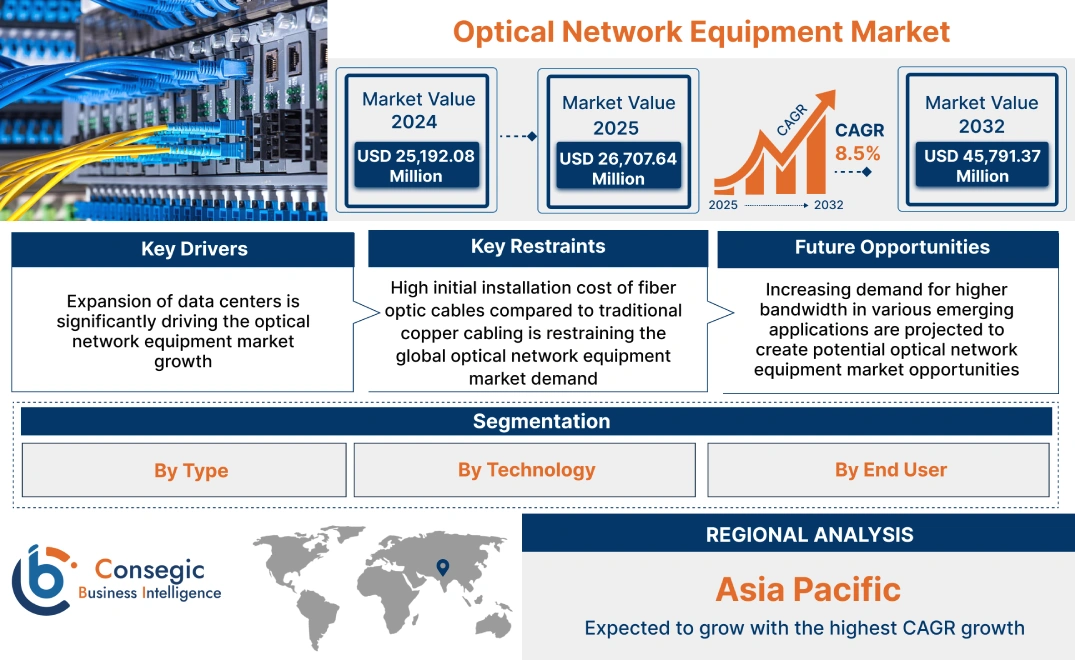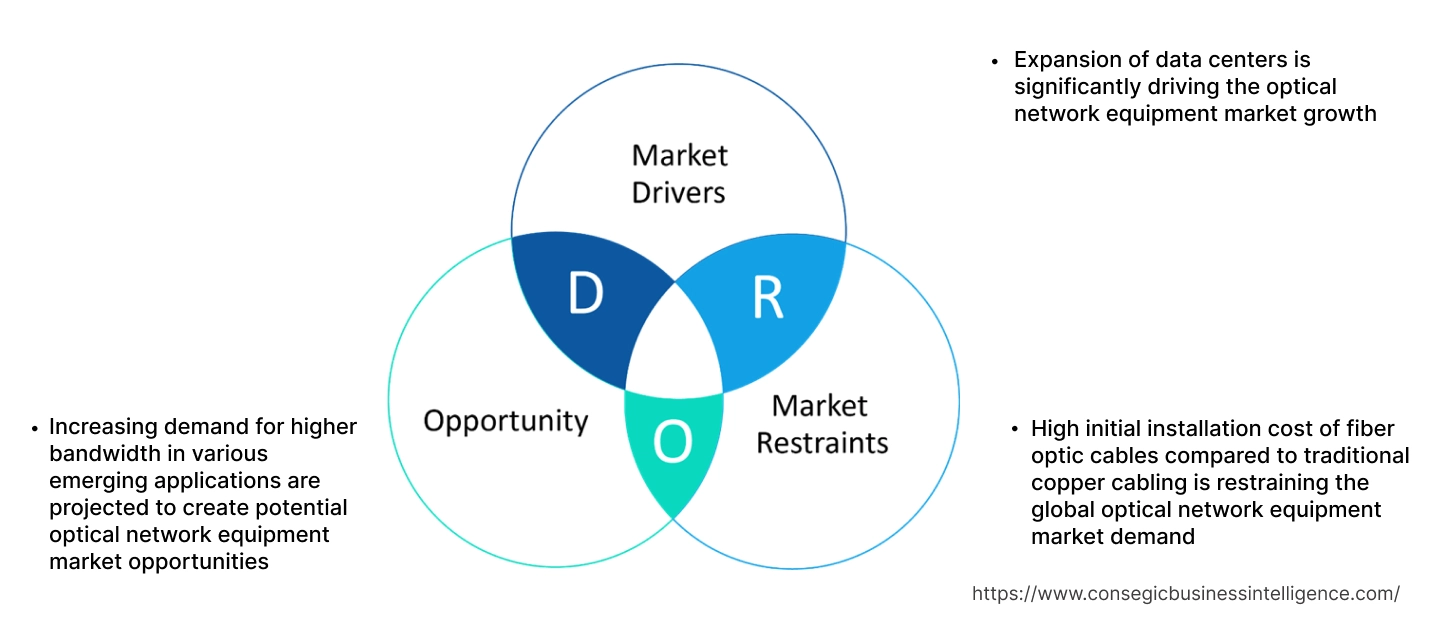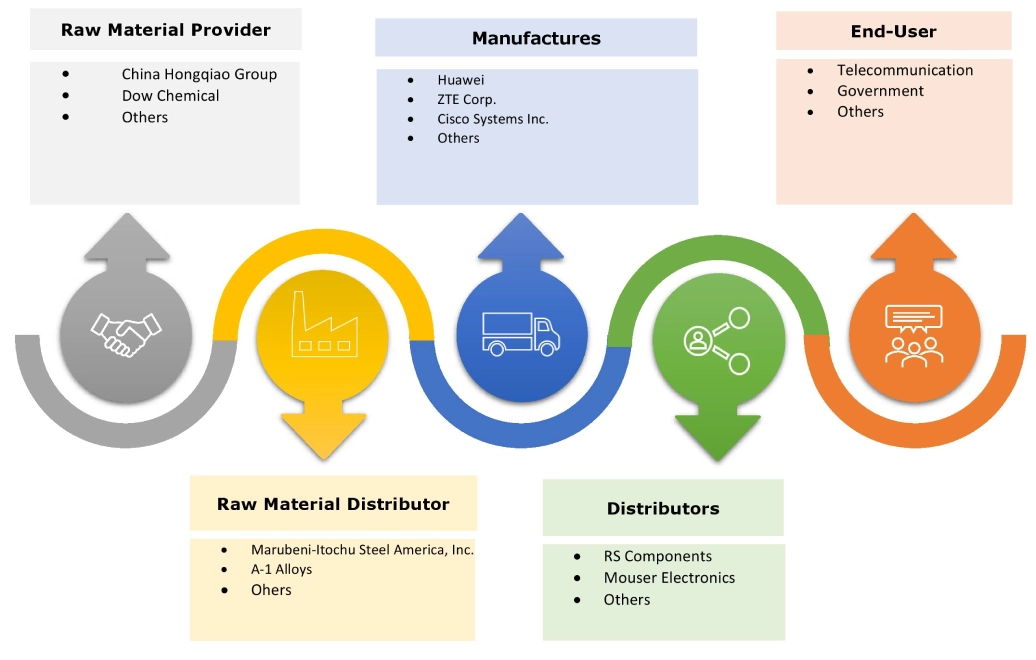- Summary
- Table Of Content
- Methodology
Optical Network Equipment Market Size:
Optical Network Equipment Market Size is estimated to reach over USD 45,791.37 Million by 2032 from a value of USD 25,192.08 Million in 2024 and is projected to grow by USD 26,707.64 Million in 2025, growing at a CAGR of 8.5% from 2025 to 2032.
Optical Network Equipment Market Scope & Overview:
Optical network equipment refers to the devices and components used in fiber optic networks to transmit data using light signals. This equipment includes optical cables, which carry light signals, and devices like Optical Network Terminals (ONTs) and Optical Line Terminals (OLTs), which convert the optical signals into electrical signals for use by computers and other devices. Routers and Ethernet cables are also part of the setup, providing wired and wireless internet access. Additionally, specialized tools like Optical Power Meters and Fiber Optic Splicers are used for network maintenance and installation.
Key Drivers:
Expansion of data centers is significantly driving the optical network equipment market growth
Data centers require enormous amounts of bandwidth to handle the constant flow of information. Optical networks, with their high capacity and speed, are essential for transmitting data within and between data centers. Additionally, modern data centers often rely on distributed architecture, with multiple facilities needing to communicate with each other. Optical networks provide the high-speed, low-latency connections necessary for efficient data transfer between these locations. Moreover, the rise of cloud computing is leading to a surge in data center construction. Cloud providers rely on massive data centers to store and process information, and these facilities are heavily dependent on optical networks to deliver their services, thus contributing to the optical network equipment market expansion.
- For instance, according to S. Census Bureau's Quarterly Workforce Indicators (QWI), data center employment in the U.S. has seen a surge, growing by over 60% nationally between 2016 and 2023 and the number of people working in data centers grew from 306,000 to 501,000 between 2016 and 2023.
Thus, the expansion of data centers creates a direct need for the high-capacity, high-speed connectivity, which in turn, is driving the optical network equipment market.
Key Restraints:
High initial installation cost of fiber optic cables compared to traditional copper cabling is restraining the global optical network equipment market demand
The raw materials for fiber optic cables are inherently more expensive than copper, hampering the market share. Moreover, specialized equipment, such as fusion splicers and optical time-domain reflectometers (OTDRs), are required for proper fiber optic cable installation and maintenance, adding to the capital expenditure. Also, the labor costs associated with fiber deployment are higher due to the need for specialized training and expertise in handling and terminating fiber cables. Unlike copper, which can be handled with simpler tools and less specialized knowledge, fiber optic installation requires precision and care to avoid damage and ensure optimal performance.
Thus, as per the market analysis, high installation cost of fiber optic cables is impeding the optical network equipment market share.
Future Opportunities :
Increasing demand for higher bandwidth in various emerging applications are projected to create potential optical network equipment market opportunities
The increasing need for bandwidth, driven by 4K/8K video streaming, online gaming, and the proliferation of IoT devices, is pushing the limits of existing GPON and XGS-PON technologies. 50G PON offers a substantial speed increase (40x faster than gigabit solutions), directly addressing this need and creating a compelling upgrade path for telecom operators. Additionally, this also supports emerging applications like 5G small cells, autonomous driving, and network slicing. These applications require significantly higher bandwidth and lower latency, which 50G PON can deliver.
- For instance, in October 2024, Broadcom introduced the BCM68660 and BCM55050, the first commercially available 50G PON OLT and ONU devices with built-in neural processing units (NPUs). These chips are designed to boost AI and machine learning at the network edge, allowing telecom operators to offer new applications over 50G fiber broadband. The BCM68660 OLT and BCM55050 ONU work together, along with other ITU-standard 50G ONUs, to provide a complete 50G PON solution.
Hence, based on the analysis, increasing need for higher bandwidth presents significant optical network equipment market opportunities.
Optical Network Equipment Market Segmental Analysis :
By Type:
Based on type, the market is categorized into FTTH (Fiber-to-the-home) and FTTB (Fiber-to-the-building).
Trends in the Type:
- FTTH is particularly important for bandwidth-intensive applications like video streaming, online gaming, and remote work.
- FTTB is a cost-effective solution for multi-tenant buildings and businesses as it offers a balance between performance and cost-effectiveness.
FTTH (Fiber-to-the-home) accounted for the largest revenue share in 2024 and is expected to register the highest CAGR over the forecast period
- 5G requires a robust fiber backhaul infrastructure, and FTTH is the ideal solution to provide the necessary high-capacity and low-latency connectivity.
- Consumers and businesses are requiring faster internet speeds. FTTH networks are being upgraded to support gigabit and even multi-gigabit speeds to meet these needs.
- Moreover, the rise of bandwidth-intensive applications like 4K video streaming, online gaming, virtual reality, and IoT devices is driving the need for faster and more reliable internet connections, further fueling the optical network equipment market trend.
- Governments worldwide are recognizing the importance of broadband connectivity and are investing in FTTH infrastructure to support economic growth and digital inclusion.
- For instance, in December 2024, India's BharatNet project has made significant strides in expanding its fiber optic network. Over 692,428 kilometers of optical fiber cable have been laid, connecting 209,281 Gram Panchayats (GPs) and making them service ready. An additional 5,032 GPs are connected via satellite, bringing the total number of service-ready GPs to 214,313. Furthermore, over 1.19 million FTTH (Fiber-to-the-Home) connections have been established by BSNL and other internet service providers using the BharatNet infrastructure. In October 2024 alone, data usage on the BharatNet network reached an impressive 139,498 terabytes.
- Thus, as per the analysis, the aforementioned factors are driving the FTTH (Fiber-to-the-home) optical network equipment market size.
By Technology:
Based on the technology, the market is segmented into Asynchronous Transfer Mode PON (APON), Broadband PON (BPON), Gigabit PON (GPON), and Ethernet PON (EPON).
Trends in Technology:
- GPON has become highly prevalent and offers high bandwidth, supports multiple services (voice, video, data), and is cost-effective.
- EPON simplifies network management and integrates seamlessly with existing Ethernet infrastructure.
GPON (Gigabit PON) segment accounted for the largest revenue share of 44.19% in 2024 and is also projected to witness the fastest CAGR during the forecast period.
- The surge in bandwidth-intensive applications like streaming, online gaming, video conferencing, and IoT devices is fueling the need for faster internet speeds. GPON technology, with its ability to deliver gigabit-speed internet, is becoming the preferred choice for service providers to meet these growing bandwidth requirements, thus driving the optical network equipment market trend.
- The growing trend of FTTH deployments using GPON technology are on the rise, especially in residential areas. Service providers are increasingly investing in FTTH infrastructure to deliver ultra-fast internet directly to households, ensuring consistent high-speed connectivity for multiple devices.
- GPON market is witnessing continuous advancements in technology, with the development of next-generation PON technologies like XG-PON, XGS-PON, and NG-PON2. These technologies offer even higher bandwidth and improved performance, catering to the evolving needs of users and applications.
- For instance, in February 2024, ZTE launched a complete 50G PON solution designed for widespread deployment. The offer features an 8-port combo PON unit supporting symmetric 50G PON, 10G PON, and GPON, along with a symmetric 50G PON ONU.
- Therefore, the aforementioned benefits offered by GPON (Gigabit PON) are bolstering the optical network equipment market size.
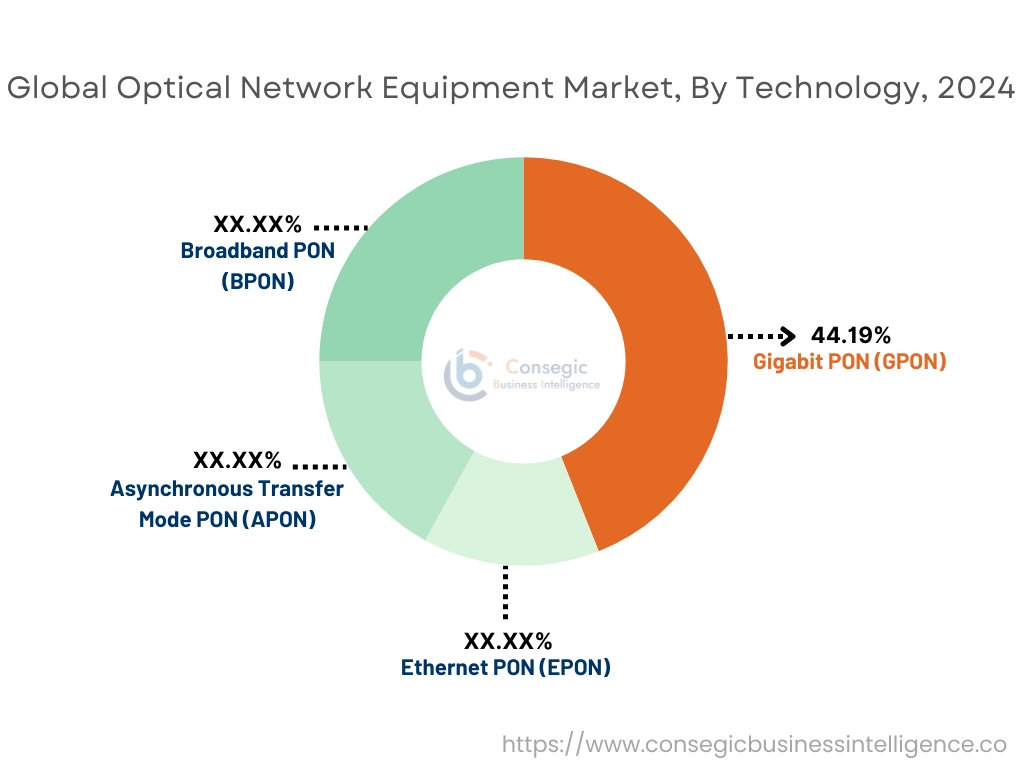
By End-User:
Based on the end user, the market is segmented into telecommunication, data centers, BFSI, healthcare, government, retail & e-commerce, media & entertainment, and others.
Trends in the End User:
- The rise of hyperscale data centers is driving need for high-capacity interconnect solutions, including 400G and 800G optical links.
- The growing adoption of telemedicine requires high-bandwidth and reliable optical networks to support video conferencing, remote patient monitoring, and data transfer.
Telecommunication accounted for the largest revenue share in the year 2024
- Telecom operators are moving away from traditional hardware-centric networks towards software-defined networking (SDN) and network function virtualization (NFV).
- AI is being integrated into various aspects of telecom operations, from network optimization and automation to customer service and fraud detection.
- 5G networks are being rolled out globally, offering faster speeds, lower latency, and increased capacity. This will enable new applications and services, such as enhanced mobile broadband, massive IoT connectivity, and mission-critical communications.
- Telecom operators are investing heavily in 5G infrastructure and spectrum to capture the growing need for 5G services, thus driving optical network equipment industry demand.
- The development of 5G ecosystems, including devices, applications, and infrastructure, is crucial for realizing the full potential of 5G.
- For instance, 5G mobile connections made up almost 40% of all mobile connections in North America in 2022. By 2030, it's predicted that over 90% of connections will be 5G. In Latin America, where 5G was only 1% of connections in 2022, it's expected to grow to 57% by 2030.
- Therefore, the aforementioned factors are contributing significantly in accelerating the optical network equipment market trend in telecommunication sector.
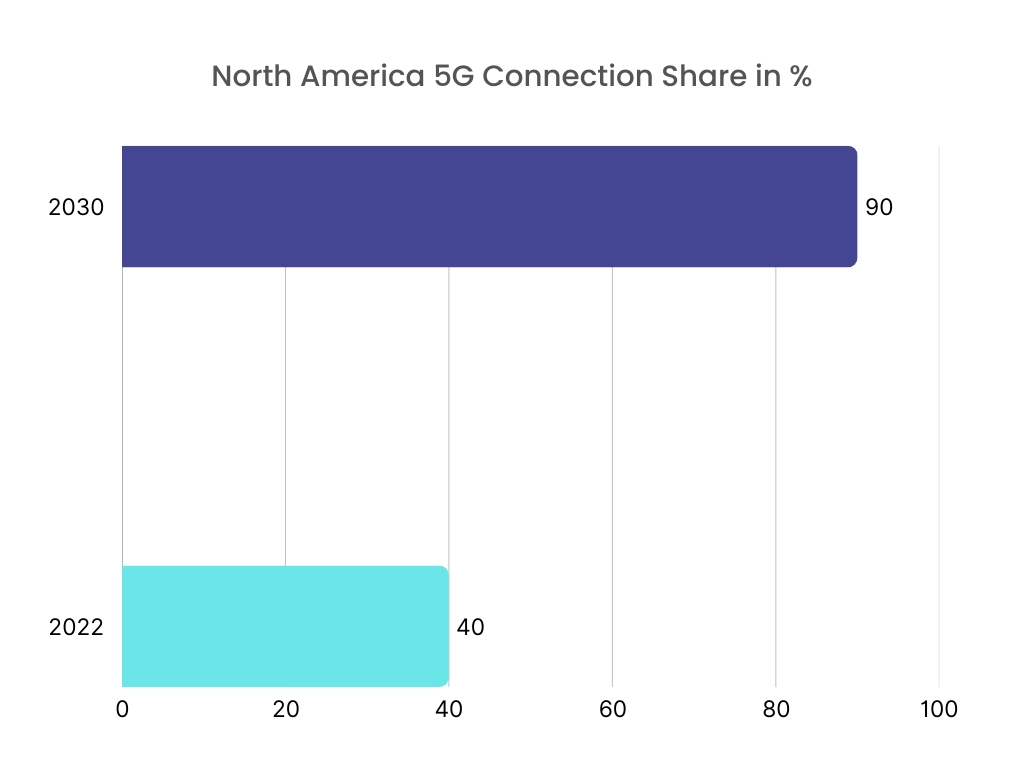
Data Centers is predicted to witness the fastest growth during the forecast period
- Data centers require massive amounts of bandwidth to support the transfer of data between servers, storage systems, and users, and driving need for high-capacity optical network equipment, such as dense wavelength division multiplexing (DWDM) systems and high-speed optical transceivers.
- Many data center applications, such as cloud computing and online gaming, require low latency to ensure good user experience, and driving trend for optical network equipment that can minimize latency, such as coherent optical systems and optical cross-connects.
- Data centers are interconnected to form a distributed network. This requires high-capacity and low-latency connections between data centers, which is driving optical network equipment market that can support data center interconnect (DCI).
- Cloud service providers rely on optical networks to connect their data centers and deliver services to users.
- Subsequently, the growing need for these equipment in data centers is boosting the market size.
Regional Analysis:
The global optical network equipment market has been classified by region into North America, Europe, Asia-Pacific, MEA, and Latin America.
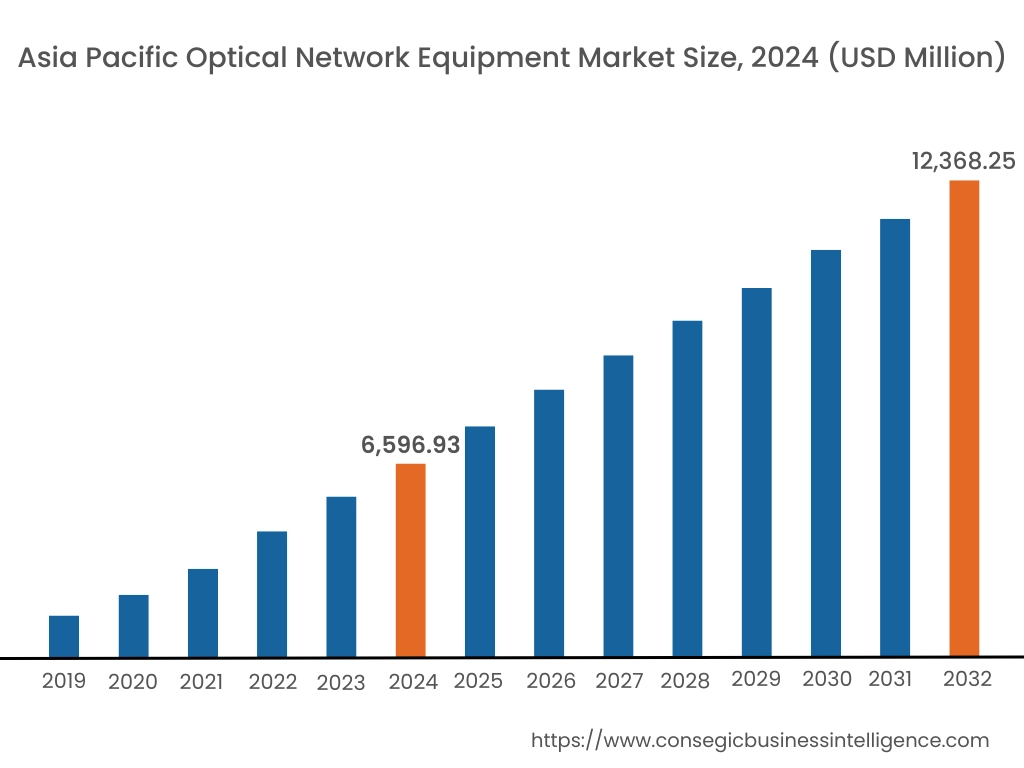
Asia Pacific region was valued at USD 6,596.93 Million in 2024. Moreover, it is projected to grow by USD 7,012.13 Million in 2025 and reach over USD 12,368.25 Million by 2032. Out of these, China accounted for the largest revenue share of 33.6% in 2024.
The proliferation of data-intensive applications, such as video streaming, online gaming, and cloud computing, has fueled the demand for high-speed internet connectivity, leading to increased investments in fiber optic networks, which are capable of delivering the required bandwidth and speed. Additionally, the rollout of 5G networks is another major catalyst for the growth of the optical network equipment market. 5G networks require a robust fiber optic backbone to support their high bandwidth and low latency requirements. Moreover, the rapid growth of data centers in the region is also contributing to the expansion of optical network equipment. Data centers require high-capacity interconnects to handle the massive amounts of data that are processed and stored. In conclusion, the aforementioned factors are collectively driving the market growth.
North America was valued at USD 8,569.07 Million in 2024. Moreover, it is projected to grow by USD 9,075.79 Million in 2025 and reach over USD 15,395.06 Million by 2032.
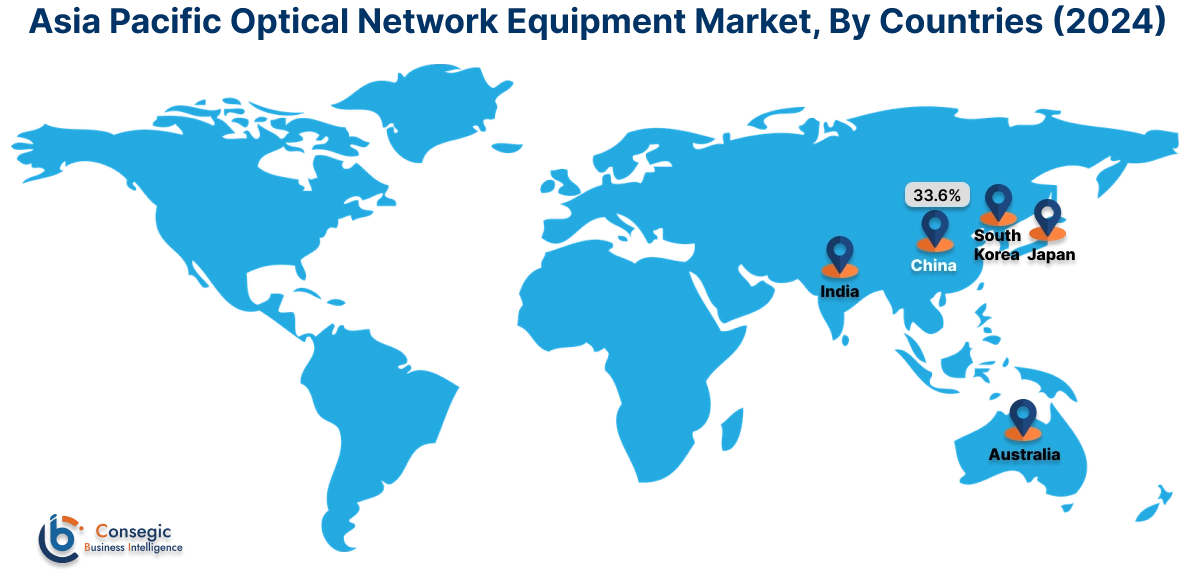
As per the analysis, the increasing reliance on bandwidth-intensive applications like streaming video, cloud computing, online gaming, and the rise of the Internet of Things (IoT) are driving the demand for faster and more reliable internet connections, directly translating to the need for advanced optical network equipment. Government programs aimed at expanding broadband access, especially in underserved rural areas, are contributing to market growth. These initiatives often involve significant investments in fiber optic infrastructure.
- For instance, in February 2025, New York Governor announced a USD 26 million ConnectALL grant for Oswego County to build a fiber-to-the-home network, expanding broadband access to 10,792 homes, businesses, and institutions in 22 towns and villages. The project will include 345 miles of fiber infrastructure, improving high-speed internet access in rural areas. This grant is part of New York State's broader Municipal Infrastructure Program, which has invested over USD 240 million in broadband projects, totaling nearly 2,400 miles of infrastructure and reaching around 98,000 locations statewide.
As per the optical network equipment market analysis, Europe’s increasing reliance on digital services, such as video streaming, online gaming, and cloud computing, is driving the demand for faster and more reliable internet connections. Additionally, the number of internet users in Latin America is growing rapidly, driving the demand for broadband infrastructure. Several Latin American governments are investing in telecommunications infrastructure to improve connectivity and promote digital inclusion. Moreover, The ME&A region has a young and growing population, leading to increased demand for telecommunications services.
Top Key Players and Market Share Insights:
The market is highly competitive with major players providing optical network equipment to the national and international markets. key players are adopting several strategies in research and development (R&D), product innovation, and end-user launches to hold a strong position in the market. Key players in the optical network equipment industry include-
- Huawei (China)
- ZTE Corp. (China)
- Cisco Systems Inc. (USA)
- Fujitsu Network Communications Inc. (USA)
- DASAN Networks (South Korea)
- Motorola Solutions (USA)
- Mitsubishi Electric Corp. (Japan)
- Verizon Communications Inc. (USA)
- Alcatel-Lucent (France)
- Calix (USA)
Recent Industry Developments :
- In December 2024, Adtran and IdeaTek partnered to bring 50G PON fiber internet to rural Kansas. Building on their existing 10G network, this upgrade will use Adtran's SDX 6400 OLT to deliver speeds of 10G, 20G, and beyond, supporting advanced applications like smart farming, remote healthcare, and AR/VR.
- In January 2021, CommScope launched the NVG578LX, a new Wi-Fi 6 residential gateway that supports 2.5G GPON, expanding its portfolio of home network solutions.
Optical Network Equipment Market Report Insights :
| Report Attributes | Report Details |
| Study Timeline | 2019-2032 |
| Market Size in 2032 | USD 45,791.37 Million |
| CAGR (2025-2032) | 8.5% |
| By Type |
|
| By Technology |
|
| By End-User |
|
| By Region |
|
| Key Players |
|
| North America | U.S. Canada Mexico |
| Europe | U.K. Germany France Spain Italy Russia Benelux Rest of Europe |
| APAC | China South Korea Japan India Australia ASEAN Rest of Asia-Pacific |
| Middle East and Africa | GCC Turkey South Africa Rest of MEA |
| LATAM | Brazil Argentina Chile Rest of LATAM |
| Report Coverage |
|
Key Questions Answered in the Report
How big is the Optical Network Equipment market? +
The optical network equipment market size is estimated to reach over USD 45,791.37 Million by 2032 from a value of USD 25,192.08 Million in 2024 and is projected to grow by USD 26,707.64 Million in 2025, growing at a CAGR of 8.5% from 2025 to 2032.
What specific segmentation details are covered in the optical network equipment report? +
The optical network equipment report includes specific segmentation details for type, technology, end-user, and regions.
Which is the fastest segment anticipated to impact the market growth? +
In the optical network equipment market, the data centers is the fastest-growing segment during the forecast period.
Who are the major players in the Optical Network Equipment market? +
The key participants in the Optical Network Equipment market are Huawei (China), ZTE Corp. (China), Cisco Systems Inc. (USA), Fujitsu Network Communications Inc. (USA), DASAN Networks (South Korea), Motorola Solutions (USA), Mitsubishi Electric Corp. (Japan), Verizon Communications Inc. (USA), Alcatel-Lucent (France), Calix (USA) and Others.
